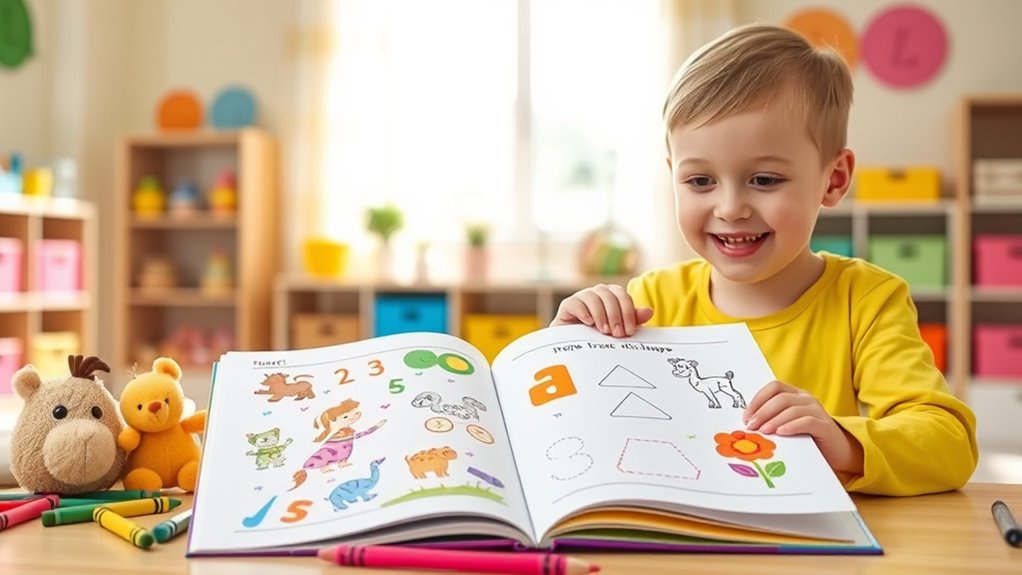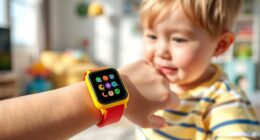If you’re looking for the best preschool workbooks for age 3 that make learning fun and easy, I recommend exploring options like the School Zone Big Preschool Workbook, Play Smart activities, and the Preschool Big Fun Workbook. These books feature colorful visuals, engaging activities, and durable designs, perfect for young learners. They cover early literacy, numbers, and cognitive skills, helping your child build confidence. Keep reading to discover more tips and top picks to find the perfect fit.
Key Takeaways
- Top preschool workbooks feature engaging visuals, colorful illustrations, and fun activities to capture 3-year-olds’ interest.
- They promote foundational skills like early literacy, counting, and motor development through age-appropriate exercises.
- Reusable and durable designs, such as laminated pages or spiral binding, enable easy practice and extended use.
- Most sets include comprehensive activities, including tracing, coloring, matching, and puzzles, making learning enjoyable.
- These workbooks are designed to be simple to use, encouraging independent learning and building confidence in young children.
School Zone Big Preschool Workbook
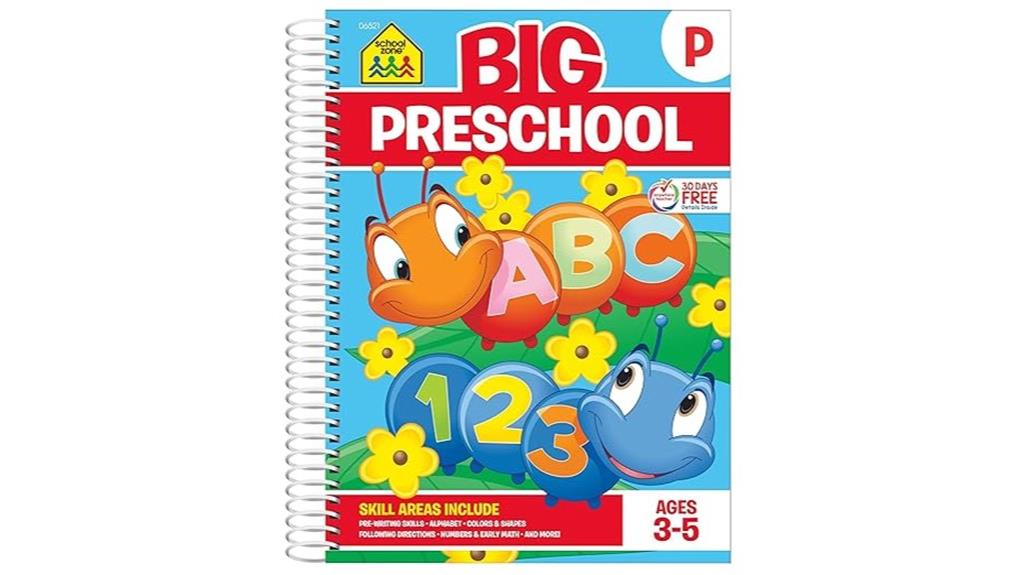
Are you looking for a preschool workbook that keeps your little one engaged while building essential skills? The School Zone Big Preschool Workbook is a fantastic choice. It offers 320 pages of colorful, interactive activities designed for ages 3-5, covering pre-writing, alphabet, colors, shapes, numbers, and early math. The spiral binding lets pages lay flat or fold for travel, making it versatile for learning at home or on the go. With activities like coloring, tracing, mazes, and hidden letter searches, it keeps kids focused and motivated. Parents love its durability, clear instructions, and structured progression, making it easier to track and support their child’s learning journey.
Best For: parents, teachers, and caregivers seeking a comprehensive, engaging preschool activity workbook to develop foundational skills in children ages 3-5.
Pros:
- Extensive 320 pages of diverse, colorful activities that promote learning and engagement.
- Durable spiral binding allows the book to lay flat or fold for easy use during travel or at home.
- Structured progression from simple to more challenging tasks supports skill development and independence.
Cons:
- The two-page spread format per letter or number may make it challenging to remove individual pages without tearing.
- Some activities may require adult supervision or guidance for optimal learning.
- The large size and weight of the workbook could be cumbersome for young children to handle independently.
Play Smart Big Preschool Workbook Ages 2-4: Over 250 Activities
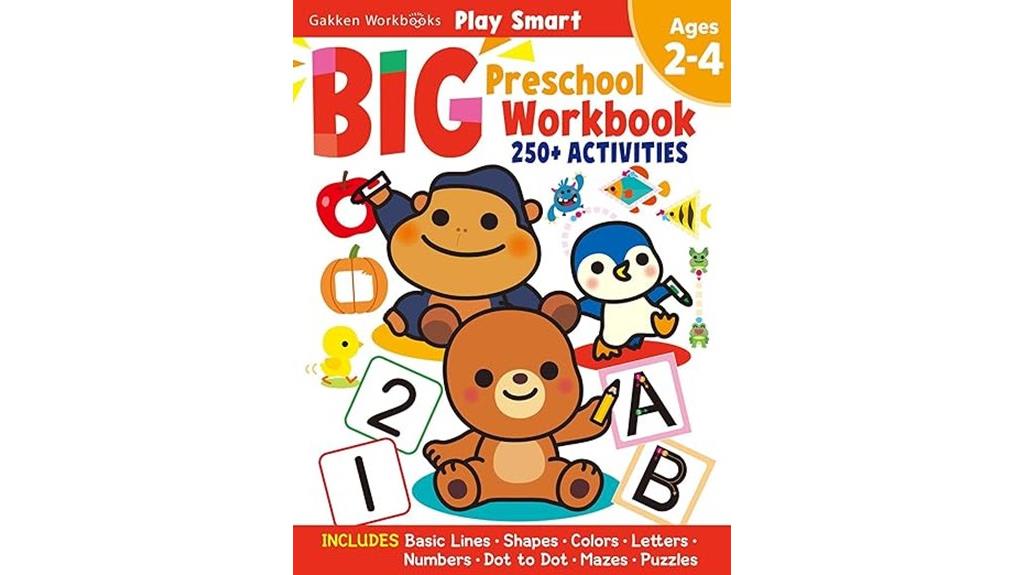
Looking for a thorough activity resource that keeps preschoolers engaged and learning? The Play Smart Big Preschool Workbook Ages 2-4 offers over 250 fun, developmentally appropriate activities. It features puzzles, mazes, dot-to-dot, matching games, and drawing exercises that entertain while building essential skills. The colorful illustrations and playful design spark curiosity and motivate kids to explore. It emphasizes letter and number writing, shape recognition, and color matching, promoting fine motor, cognitive, and problem-solving skills. Suitable for kids aged 2 to 4, it’s versatile, easy to use, and perfect for independent practice or family fun. It’s an excellent tool to make learning both enjoyable and effective.
Best For: parents, caregivers, and educators seeking a comprehensive, engaging activity resource for children aged 2 to 4 to promote early learning and developmental skills.
Pros:
- Offers over 250 diverse activities that keep children entertained and learning for hours
- Focuses on essential preschool skills like letter and number writing, shape recognition, and color matching
- Durable and versatile, pages can be laminated for repeated use with dry erase markers
Cons:
- Some activities may be challenging for 2-year-olds, requiring adult assistance
- The wide variety of activities might be overwhelming for some children or caregivers to organize
- Not specifically tailored for children with special learning needs or advanced skills
Preschool Big Fun Workbook
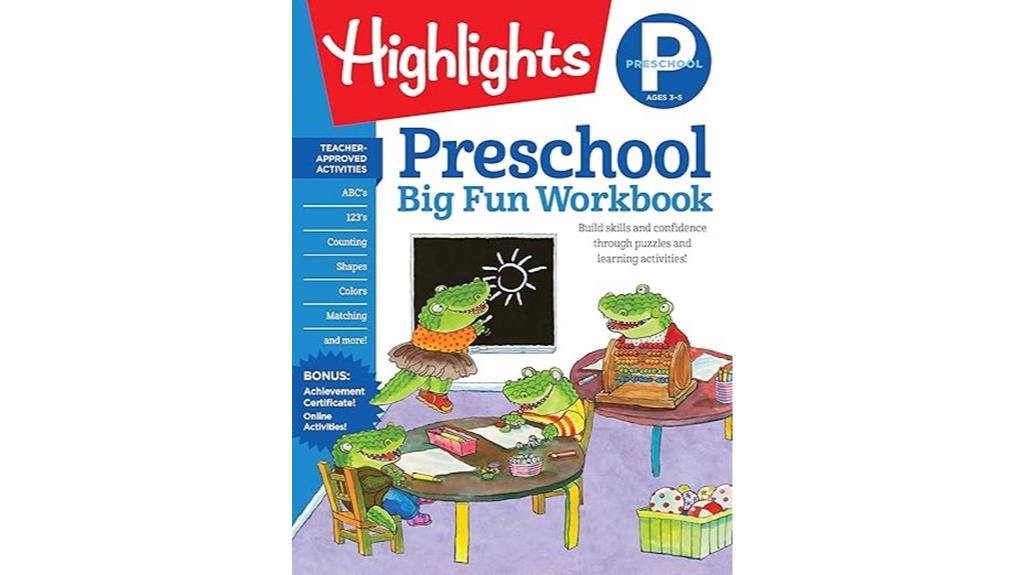
The Preschool Big Fun Workbook is an excellent choice for parents and educators seeking an extensive, engaging resource to support preschoolers’ early learning. With 256 pages, it covers essential skills like letter recognition, sight words, counting, patterns, shapes, and colors through fun activities. Its puzzle-based approach, including Hidden Pictures, mazes, and matching games, keeps children motivated and excited. The workbook is endorsed by educators, aligned with curriculum standards, and offers helpful tips for parents. Its bright visuals, sturdy pages, and inclusion of stickers make learning enjoyable and portable. Overall, it’s a versatile tool that promotes confidence, fine motor skills, and a love for learning.
Best For: parents and educators seeking a comprehensive, engaging preschool workbook to develop early literacy, math, and cognitive skills in children ages 3-5.
Pros:
- Rich, colorful visuals and well-designed pages that make learning fun and motivating.
- Includes a variety of activities such as puzzles, tracing, coloring, and matching to support diverse learning styles.
- Endorsed by educators and aligned with curriculum standards, ensuring educational relevance.
Cons:
- Some activities may feel repetitive or slightly advanced for certain preschoolers.
- Not all content aligns perfectly with common core standards, so it should be used as a supplemental resource.
- The extensive number of pages might be overwhelming for some children or parents to complete entirely.
School Zone Preschool Workbook for Ages 3-5

If you’re searching for a preschool workbook that effectively prepares children aged 3 to 5 for kindergarten, the School Zone Preschool Basics Workbook stands out as an excellent choice. It features 64 colorful pages packed with engaging activities that cover colors, numbers, matching, sounds, patterns, and rhymes. Designed to boost fine motor skills and early literacy, the workbook encourages independent work with clear instructions and step-by-step examples. Its perforated pages make it easy to tear out for travel or classroom use. Parents and teachers praise its fun, educational content that keeps kids motivated while reinforcing essential preschool skills. It’s a practical, enjoyable resource for early learning success.
Best For: parents, teachers, and caregivers seeking an engaging, comprehensive preschool activity book to prepare children aged 3-5 for kindergarten.
Pros:
- Colorful pages with a variety of fun, age-appropriate activities that promote early learning skills.
- Encourages independent work with clear instructions and step-by-step examples.
- Perforated pages allow for easy tear-out, making it convenient for travel and classroom use.
Cons:
- Some users report that the binding may weaken over time, causing pages to fall out.
- The workbook may not be suitable for children who need more advanced or customized activities.
- Limited space for writing, which might be less ideal for children ready to practice handwriting.
My First Learn-to-Write Workbook for Kids

Are you searching for a beginner-friendly workbook that helps young children develop essential writing skills? My First Learn-to-Write Workbook for Kids is perfect for preschoolers and kindergartners just starting their writing journey. It offers over 75 engaging pages with activities like tracing lines, shapes, letters, and numbers. The step-by-step guidance builds confidence, fine motor skills, and early literacy. The sturdy pages and colorful illustrations keep kids motivated, while the variety of exercises prevents boredom. Whether homeschooling or supplementing classroom learning, this workbook effectively prepares children for more advanced writing tasks and fosters independence in a fun, supportive way.
Best For: young children, especially preschoolers and kindergartners, who are beginning their writing journey or recovering from medical setbacks.
Pros:
- Engaging activities that build confidence and foundational skills
- Durable pages and sturdy covers suitable for repeated use
- Colorful illustrations and clear instructions that motivate independent practice
Cons:
- Some pages may feel repetitive for advanced learners
- Limited variety in challenges as children progress
- Designed for early learners, so may not suit older children seeking more advanced content
Magic Grooved Practice Copybook 5 Pack with Pens
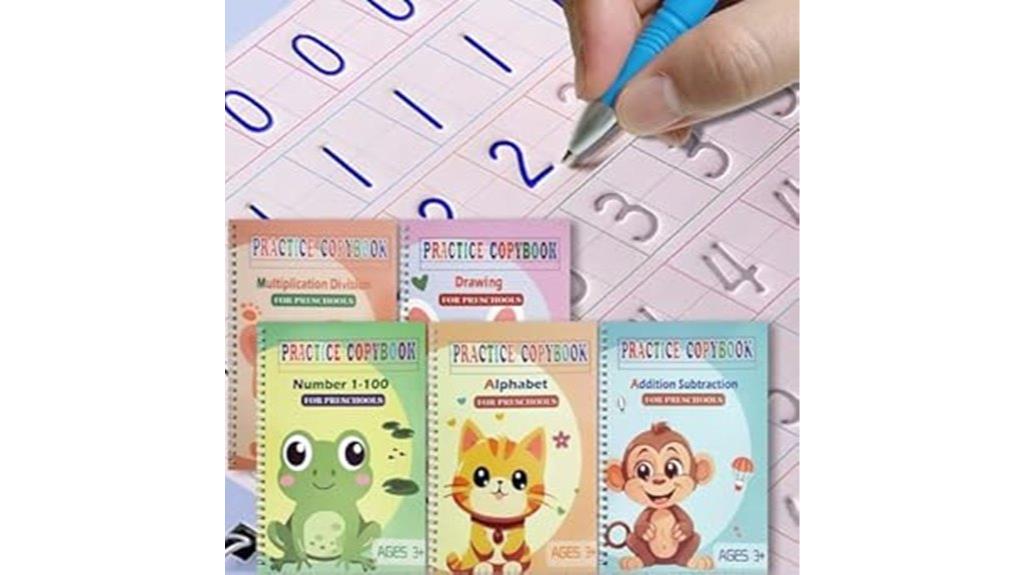
Looking for a fun, interactive way to help your preschooler develop essential skills? The Magic Grooved Practice Copybook 5 Pack with Pens is perfect. It includes five reusable practice books covering alphabet, math, and drawing, plus two pens, refills, and pen holders for easy use. The thick, durable paper features a three-dimensional groove design that guides handwriting and shapes, fostering fine motor skills. The magic ink fades after 30 minutes, allowing endless practice without waste. It’s ideal for handwriting, math, and creativity, making learning engaging and mess-free. Plus, it’s a thoughtful gift for children aged 3-8 who love to learn through play.
Best For: preschool children aged 3-8 who are eager to develop handwriting, math, and drawing skills through engaging, reusable practice books.
Pros:
- Includes multiple practice books, pens, refills, and pen holders for comprehensive learning.
- Thick, durable paper with a three-dimensional groove design guides correct handwriting and shapes.
- Magic ink allows for repeated practice as it automatically fades within 30 minutes, reducing waste.
Cons:
- Suitable primarily for children within the 3-8 age range; may not meet the needs of older students.
- Requires patience for ink to fade before reusing the pages, which might be inconvenient for quick practice sessions.
- Limited to basic math and handwriting skills; may need additional resources for advanced learning.
Preschool Tracing and Learning Books for Kids
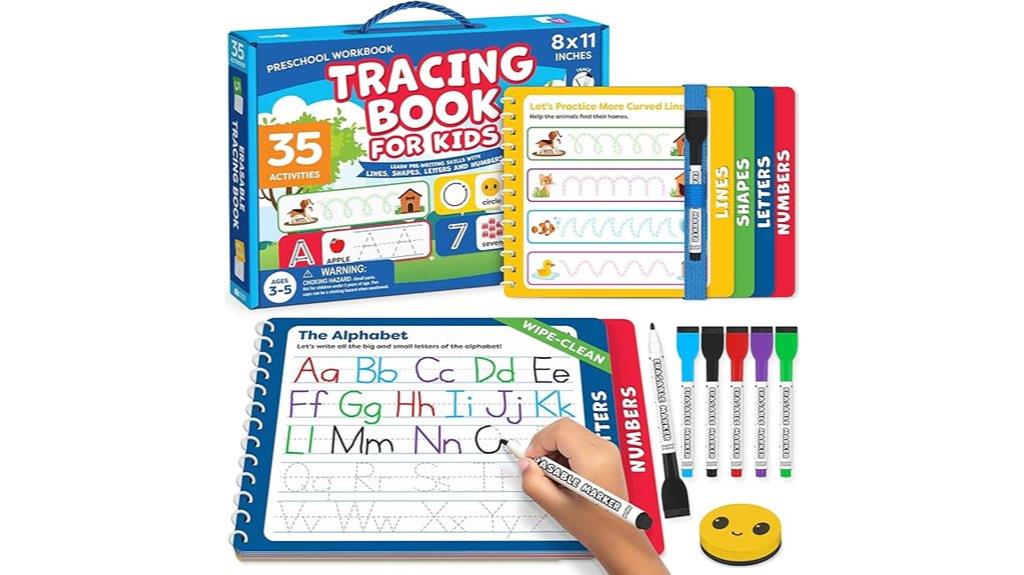
Parents and educators seeking a thorough, engaging learning tool for preschoolers will find preschool tracing and learning books an excellent choice. This complete set includes all-in-one tracing books, a dry-erase workbook, markers, and a smiley eraser, making it perfect for independent learning at home or school. Designed to support early handwriting, fine motor skills, and kindergarten readiness, it offers 35 activities covering letter tracing, shapes, lines, and numbers 1-10. Made from non-toxic, durable materials, these reusable tools promote confidence and skill development in a fun, screen-free format. It’s an ideal gift to nurture early literacy and motor skills in young learners.
Best For: parents, teachers, and caregivers seeking a comprehensive, engaging, and reusable learning tool to support preschoolers’ early literacy, fine motor skills, and handwriting development at home or in the classroom.
Pros:
- All-in-one set with tracing books, dry-erase workbook, markers, and accessories for a complete learning experience
- Promotes independent, screen-free skill development in early literacy and motor coordination
- Durable, non-toxic materials designed for repeated use by young children
Cons:
- May require supervision to ensure proper use of markers and erasers
- Some children might outgrow the activities quickly and need additional resources
- The set’s size and components might be too large for very small children to carry easily
My First Learn-to-Read Preschool Workbook
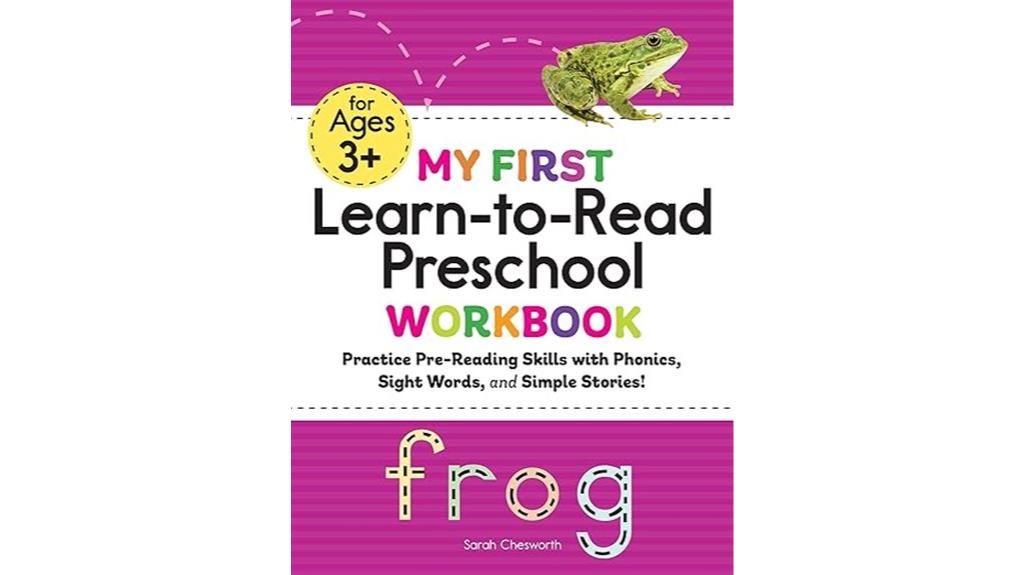
The My First Learn-to-Read Preschool Workbook is an excellent choice for children aged 3 to 5 who are just beginning their journey into reading. It aligns with Pre-K curriculum standards, making it perfect for homeschoolers and preschoolers alike. The workbook teaches alphabet recognition, letter sounds, sight words, and word families through engaging activities like fill-in-the-blanks, matching, and repetition. With over 75 practice pages, it keeps children interested while building foundational literacy skills. Bright illustrations and interactive exercises make learning fun and boost confidence. This workbook effectively prepares young learners for future academic success by strengthening reading, writing, and critical thinking skills.
Best For: young children ages 3 to 5, especially preschoolers and homeschoolers beginning their literacy journey.
Pros:
- Engaging activities that reinforce alphabet, sight words, and early reading skills.
- Bright, colorful illustrations that stimulate imagination and make learning enjoyable.
- Over 75 practice pages offering variety to maintain interest and build confidence.
Cons:
- May require adult supervision or guidance for optimal use by very young children.
- Limited to early literacy; may need supplementary materials for advanced learners.
- Some children might find repetitive exercises less challenging over time.
School Zone Thinking Skills Workbook
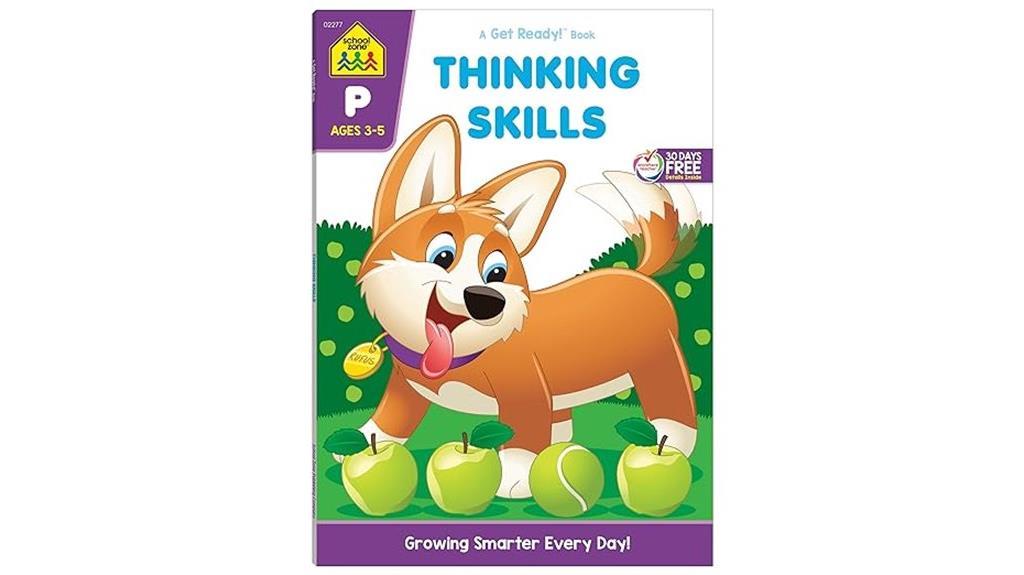
If you’re searching for a workbook that truly sharpens your preschooler’s thinking skills, the School Zone Thinking Skills Workbook is an excellent choice. With 64 pages packed with activities like classifying, sequencing, pattern recognition, matching, counting, coloring, and problem-solving, it covers essential early skills. Designed for ages 3-5, it promotes observation, reasoning, focus, and attention to detail. The perforated pages and glossy cover make it portable and durable for on-the-go learning. Kids will enjoy completing picture analogies and logic puzzles, making learning engaging and hands-on. It’s a practical, well-designed resource that helps prepare children for kindergarten and beyond.
Best For: parents and educators seeking an engaging, portable, and age-appropriate workbook to develop early thinking and reasoning skills in preschoolers aged 3-5.
Pros:
- Offers a comprehensive variety of activities to target multiple cognitive skills such as classification, sequencing, and pattern recognition.
- Perforated pages and glossy cover enhance durability and portability for on-the-go learning.
- Recognized with multiple educational awards, indicating high quality and effectiveness.
Cons:
- Some activities may be challenging or vague for certain children, requiring adult guidance.
- The workbook is focused primarily on early thinking skills and may need to be supplemented with other learning resources.
- As a physical product, it may not appeal to children who prefer digital or interactive learning tools.
School Zone Get Ready for Preschool Workbook
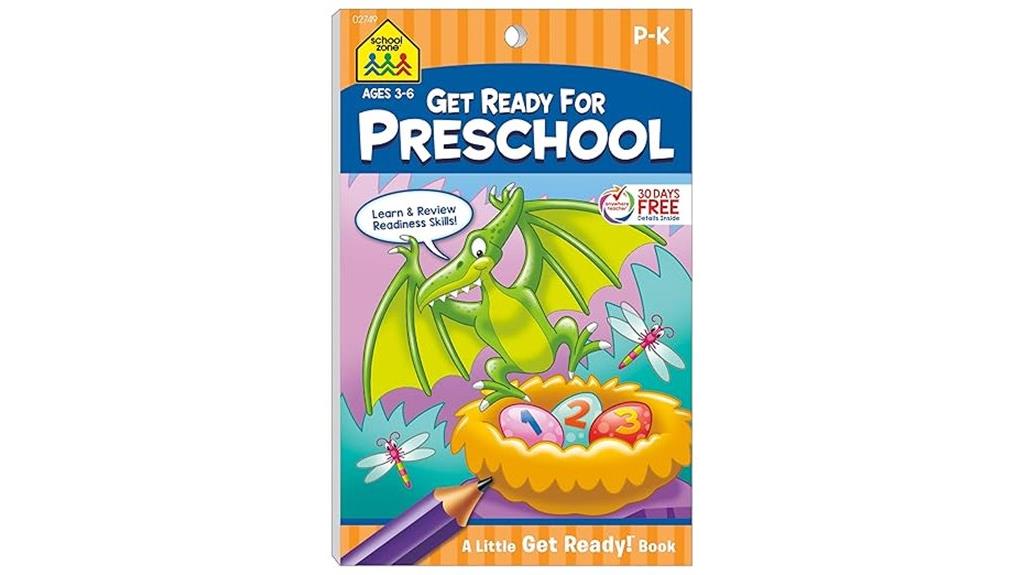
Looking for a preschool workbook that helps young children get comfortable with basic skills? The School Zone Get Ready for Preschool Workbook offers 48 pages packed with activities to prepare kids aged 3-6 for preschool. It covers ABCs, numbers, colors, rhyming, and matching, promoting early reading and problem-solving skills. The activities include mazes, search-and-find tasks, and phonics exercises that make learning fun and engaging. Designed for self-directed learning, it also helps develop fine motor skills through pencil tasks. Though small and black-and-white, it’s a portable option perfect for travel, quiet time, or summer learning.
Best For: parents and educators seeking a portable, low-cost workbook to reinforce preschool readiness skills for children around age 5, especially during travel or quiet time.
Pros:
- Engages children with a variety of fun activities like mazes and search-and-find tasks.
- Promotes foundational skills such as ABCs, numbers, colors, and phonics.
- Compact size makes it easy to carry and use anywhere.
Cons:
- Small, black-and-white pages may reduce visual engagement for some children.
- Paper quality is considered poor, affecting durability.
- Might be less suitable for younger children (ages 3-4) due to size and presentation.
Preschool Learning Activities Workbook for Kids
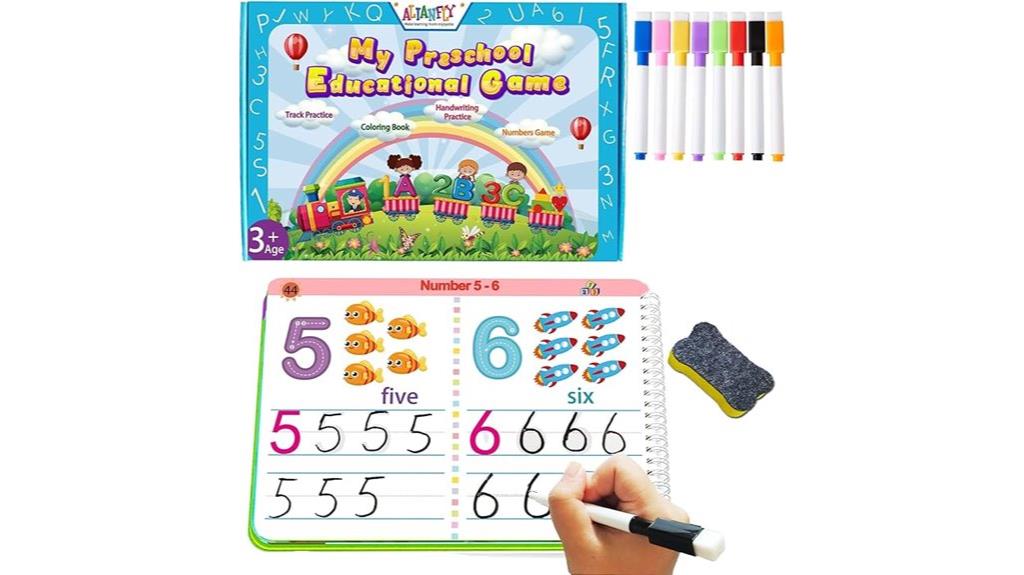
Are you searching for a fun, interactive way to help your preschooler develop essential skills? The Preschool Learning Activities Workbook for Kids is perfect. It features 51 pages of engaging activities like handwriting practice, tracing, coloring, and drawing. Plus, it comes with 8 markers and an eraser, making learning versatile and reusable. The workbook promotes fine motor skills, hand-eye coordination, and early literacy through themed sections on letters, numbers, animals, and more. Its erasable surface allows kids to practice repeatedly, building confidence. Ideal for home or classroom use, it encourages independent learning while fostering parent-child interaction. It’s a fantastic tool for making early education both fun and effective.
Best For: preschoolers aged 3-7, parents, teachers, and caregivers seeking a fun, interactive educational activity to develop early literacy, motor skills, and cognitive abilities.
Pros:
- Reusable, erasable surface allows for multiple practice sessions, promoting confidence and mastery.
- Includes 8 markers and an eraser, making it a comprehensive and versatile learning set.
- Engages children with themed activities that support early literacy, shape recognition, and problem-solving skills.
Cons:
- Some users have noted occasional questionable examples for letter recognition.
- May not be suitable for children outside the age range of 3-7 or those requiring more advanced activities.
- Limited to the activities and themes provided; may need supplementary resources for broader curriculum needs.
Ocean Animals Preschool Activity Book
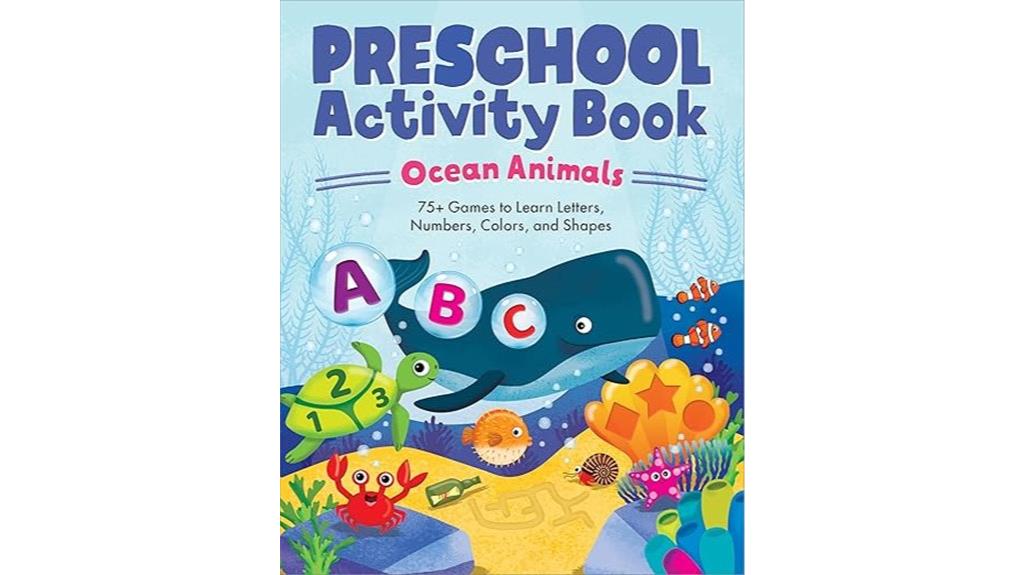
The Ocean Animals Preschool Activity Book stands out as an ideal choice for parents and educators seeking engaging, age-appropriate activities for children under five. It offers colorful, ocean-themed illustrations and a variety of exercises like tracing, coloring, mazes, and matching games that help develop fine motor skills, problem-solving, and early literacy. Designed for children aged 3 to 5, it’s perfect for homeschooling, quiet afternoons, or car rides. The sturdy, portable format guarantees durability and ease of use on the go. While some activities may be simple, this book provides an entertaining way to introduce preschoolers to basic school concepts through fun ocean adventures.
Best For: parents, teachers, and homeschoolers seeking engaging, age-appropriate ocean-themed activities to support early learning for children aged 3 to 5.
Pros:
- Colorful, vibrant illustrations that capture children’s attention and make learning fun
- Wide variety of activities including tracing, coloring, mazes, and matching games to promote multiple skills
- Durable, portable format ideal for travel, outings, and screen-free activities
Cons:
- Some activities may be too simple or already marked, possibly limiting challenge for some children
- Not all activities may be age-appropriate for every preschooler, requiring adult supervision or guidance
- Limited focus on advanced concepts, primarily suited for early foundational skills
Scholastic Toddler Jumbo Workbook
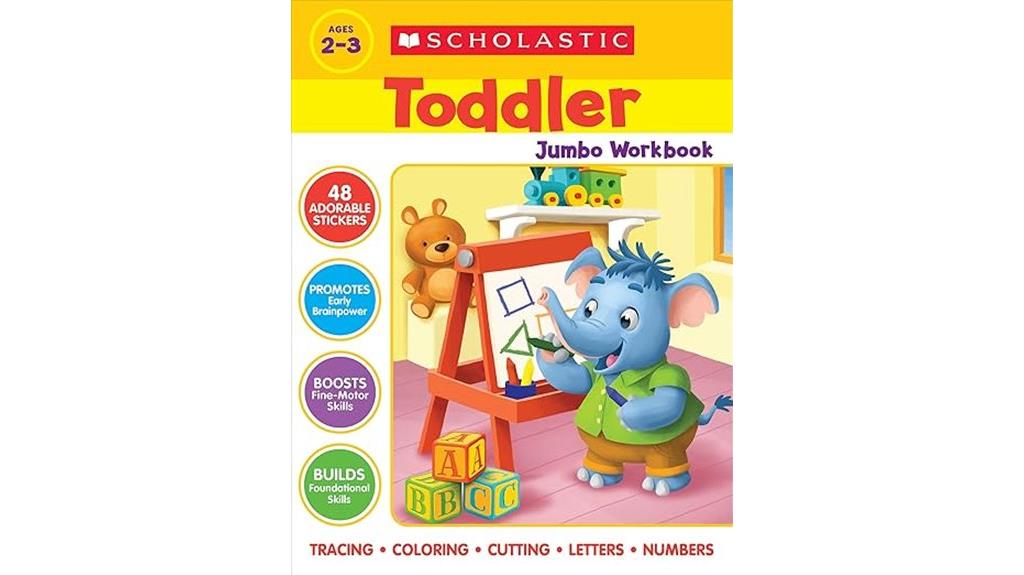
If you’re searching for a versatile workbook that keeps toddlers engaged while building essential skills, the Scholastic Toddler Jumbo Workbook is an excellent choice. It offers a wide range of activities like coloring, tracing, cutting, counting, and shape recognition, all designed to prepare kids for preschool. The pages are thick and colorful, making them perfect for crayons and markers, with perforations for easy display or tearing out. Kids enjoy the engaging visuals and hands-on tasks, which help develop fine-motor skills and early literacy. Parents appreciate its durability and the opportunity for quality time. It’s a well-rounded tool to support early learning at home.
Best For: parents and caregivers seeking a comprehensive, engaging workbook to develop preschool-ready skills and fine motor abilities in toddlers aged 2-5.
Pros:
- Wide variety of activities including coloring, tracing, cutting, and shape recognition that promote early development.
- Durable, thick pages with perforations for easy removal and display, suitable for use with crayons and markers.
- Highly engaging visuals and hands-on tasks that make learning enjoyable and foster quality time between children and adults.
Cons:
- Some pages, like alphabet activities, are double-sided, which could be improved by dedicated single-sided pages for easier use.
- Certain activities may be above a child’s current skill level, potentially requiring adult guidance or repeated practice.
- While sturdy, laminated pages or frequent use may eventually cause wear, necessitating careful handling for long-term durability.
Factors to Consider When Choosing Preschool Workbooks Age 3
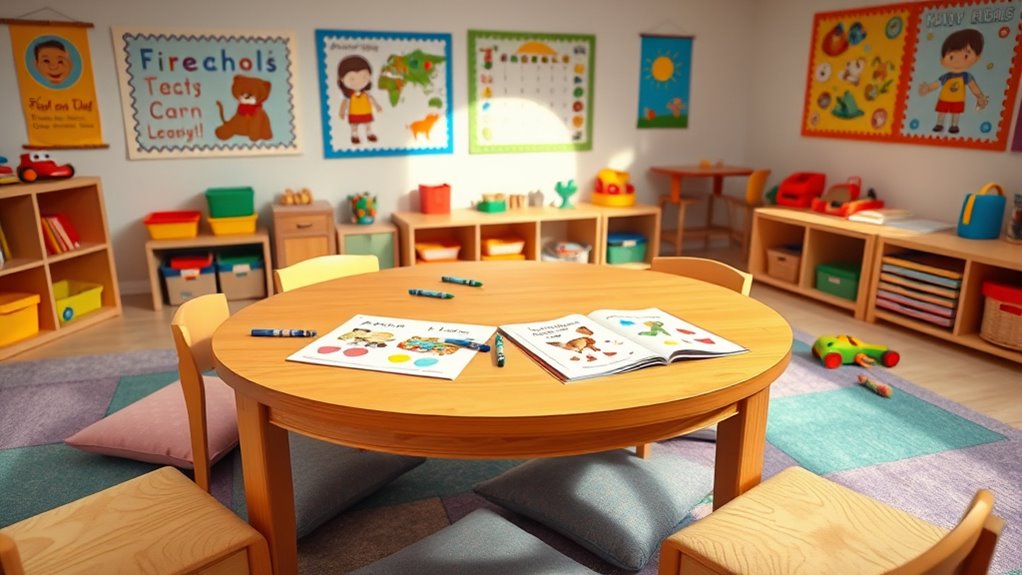
When choosing preschool workbooks for age 3, I focus on content that’s appropriate and engaging for their developmental stage. I also consider how well the workbook supports skill-building, holds up over time, and captures their interest visually. Ultimately, I look for designs that are simple to use and durable enough for little hands.
Age-Appropriate Content Focus
Choosing preschool workbooks for age 3 means selecting materials that match their developmental milestones, such as recognizing basic shapes and colors, practicing simple tracing, and gaining early number awareness. The content should be engaging without being too complex, so children stay motivated and avoid frustration. Activities should focus on developing fine motor skills through coloring, tracing, and cutting, which are ideal for strengthening hand-eye coordination. The difficulty level needs to gradually increase, starting with simple tasks and progressing as the child’s abilities grow. Visuals and themes should be colorful and appealing, capturing their interest and supporting early literacy and cognitive development. When content is age-appropriate, it makes learning both fun and effective for your little one.
Skill Development Opportunities
What should you look for in a preschool workbook to support your 3-year-old’s skill development? First, check for activities that strengthen fine motor skills, like tracing, coloring, and cutting, which build hand strength and coordination. Look for opportunities that introduce early literacy skills, such as letter recognition, phonics, and simple word matching, laying a foundation for reading. Math skills are essential too—choose workbooks with counting exercises, number recognition, and pattern activities to foster early numeracy. Sensory and categorization tasks, like sorting by shapes or colors, boost cognitive development and classification skills. In conclusion, select a variety of engaging tasks that gradually increase in difficulty, encouraging progress while keeping your child motivated and excited to learn.
Durability and Material Quality
Selecting a preschool workbook that can withstand daily use begins with examining its durability and material quality. Look for workbooks made with thick, high-quality paper that can handle repeated erasing, coloring, and handling by little hands without tearing. The binding should be sturdy—preferably spiral-bound—to prevent pages from falling out after frequent use. A durable cover, such as glossy or laminated, helps protect against spills, stains, and rough handling, keeping the workbook looking new longer. Reinforced edges or binding further minimize wear and tear, especially for active or clumsy children. Ultimately, ensure the materials are non-toxic and safe for children, so you can feel confident that your little learner is using a safe, long-lasting resource that stands up to daily adventures.
Visual Engagement Factors
Have you noticed how bright, colorful illustrations can instantly grab a preschooler’s attention? Eye-catching graphics motivate children to participate and explore learning activities. Look for workbooks with visual clarity—large, simple images and minimal clutter help kids easily identify objects and concepts. Themed visuals, like animals or familiar objects, make learning more relatable and engaging. Clear, bold fonts combined with visual cues support independent understanding, reducing frustration. Interactive elements such as search-and-find activities or matching images boost visual engagement and keep young learners focused. These visual engagement factors not only make learning fun but also foster curiosity and attention, helping preschoolers develop essential skills in an enjoyable way. Choosing workbooks with these visual features guarantees your child stays motivated and eager to learn.
Ease of Use Design
When choosing a preschool workbook for age 3, ease of use is essential to support independent learning. I look for workbooks with clear, simple instructions that kids can follow without constant help. Well-designed layouts with plenty of space and large, recognizable illustrations make it easier for little ones to navigate activities confidently. Durability is also key—thick pages and sturdy binding prevent tearing and withstand repeated use. Visual cues and minimal text reduce cognitive load, helping children complete tasks more independently. Additionally, age-appropriate activity complexity with a logical progression builds confidence and prevents frustration. These features ensure that the workbook is not only engaging but also accessible, making learning fun and self-directed for young learners.
Reusability and Flexibility
Choosing a preschool workbook that can be reused and adapted keeps learning fresh and engaging for young children. Reusable workbooks often feature dry-erase surfaces or laminated pages, allowing kids to practice skills repeatedly without wasting paper. Durable materials like thick cardstock or laminated sheets extend the workbook’s lifespan, making them a practical investment. Workbooks with perforated pages offer added flexibility, letting children tear out activities for independent use or sharing. This design supports different learning needs and helps foster independence, as kids can correct mistakes and redo exercises as often as needed to reinforce their understanding. Additionally, flexible activities that can be erased or adjusted for various skill levels make these workbooks suitable for a range of developmental stages within age 3, keeping learning adaptable and fun.
Educational Alignment Standards
Ensuring a preschool workbook aligns with recognized educational standards is essential to support consistent and meaningful learning for your child. I recommend checking if the workbook follows standards like Common Core or state preschool benchmarks, ensuring activities promote key skills such as letter recognition, number sense, shapes, and colors. It’s important that the content gradually increases in difficulty to match your child’s developmental stage, fostering skill mastery. Look for evidence of diverse learning modalities—visual, kinesthetic, and auditory activities—that meet standards for all learners. Additionally, confirm that the themes and skills support preschool readiness, emphasizing fine motor skills, early literacy, and math concepts. Proper alignment guarantees the workbook not only makes learning fun but also builds a solid foundation for your child’s educational journey.
Frequently Asked Questions
How Can I Ensure Workbooks Match My Child’s Learning Style?
When choosing workbooks, I consider my child’s interests and how they learn best. I observe whether they prefer hands-on activities, visual cues, or simple instructions. I also try different types of workbooks to see which ones keep them engaged and motivated. By paying attention to their reactions and progress, I can select materials that match their unique learning style and make the experience enjoyable and effective.
Are Digital or Printable Workbooks Better for Preschoolers?
Imagine choosing between a sturdy paper map or a sleek GPS for your journey. I believe printable workbooks are like maps—tangible, easy to customize, and less distracting. Digital workbooks, like GPS, are sleek but can sometimes lead to distractions. For preschoolers, I recommend printable workbooks; they’re hands-on, engaging, and foster better focus. Plus, they’re easy to use anywhere, making learning more accessible and fun.
How Do I Balance Workbook Activities With Play-Based Learning?
Balancing workbook activities with play-based learning is key to a child’s development. I find that mixing structured tasks with free play keeps my little one engaged and happy. I set specific times for workbook activities, then allow plenty of unstructured play to explore and discover. This approach helps my child develop skills while fostering creativity and independence, making learning both fun and effective.
What Are Signs My Child Is Ready for More Advanced Workbooks?
When thinking about my child’s readiness for more advanced workbooks, I look for signs like increased focus, curiosity, and confidence in completing tasks. It’s a bit like watching a seed sprout—it hints at growth but needs the right environment. If your child enthusiastically tries new challenges, asks questions, and shows persistence, they’re likely ready. Remember, progress varies, so trust your instincts and celebrate small victories along the way.
How Often Should Preschool Workbooks Be Updated or Changed?
I believe preschool workbooks should be updated or changed every few months, around three to four, to match your child’s growing skills and interests. Regularly switching them keeps learning fresh and engaging, preventing boredom. If your child shows signs of mastering a workbook quickly, it’s a good idea to move on sooner. Always observe their enthusiasm and challenge level, adjusting the materials to keep them motivated.
Conclusion
So there you have it—your ultimate list of preschool workbooks that make learning feel like play. Because who wouldn’t want to turn the chaos of toddlerhood into a series of adorable, educational adventures? Just pick one (or two), and watch your little one conquer numbers, letters, and ocean animals—all while you secretly do a happy dance. After all, what’s better than tiny humans learning without you losing your mind?

